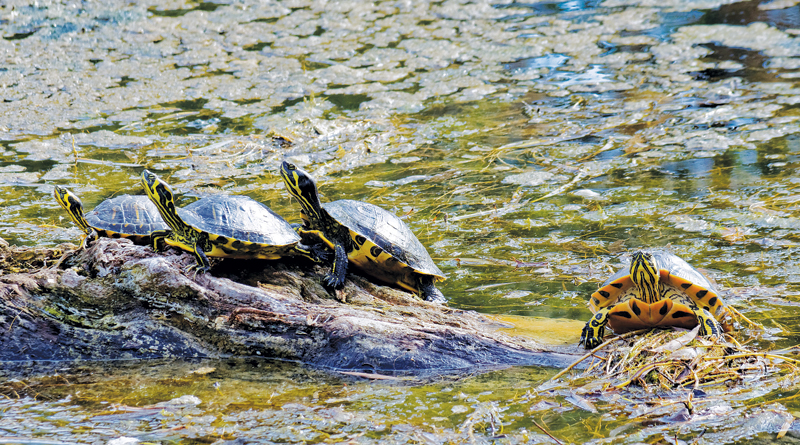TURTLES ARE SO INTERESTING! – Life In The Outdoors

“Turtle,” I said to my daughter when I saw one in the road ahead. My daughter, who was driving, had seen it too and was slowing the car as I spoke. There were no other cars on the road so my daughter stopped the car a few feet from the turtle and I opened my door, got out, walked around to the front of the car and picked the turtle up.
It was a small turtle. Its carapace, or upper shell, was only about the size of a salad plate though oblong, not round. It drew its head, legs and tail back between the two halves of its shell, the carapace, and plastron, and clamped them together as I picked it up.
The turtle had mud on its carapace, as if it had just emerged from the mud, and out of its wintering place. But that couldn’t be. I’d been seeing other turtles like it for a week or more on sunny days on logs in marshes and ponds. Still, it was a sign of spring, like the robins I have been seeing daily on my lawn, or the tree swallows now flitting about over our marsh and pasture during the day.
My daughter and I looked the turtle over and decided it was a painted turtle. Then I carried it away from the road, in the direction it had been going, and put it down. In less than a minute it opened up, stuck its head out, then its feet, legs, and tail, then started scuttling off through the grass.
Turtles are believed to be very old, perhaps the oldest animals on earth. They were on earth before dinosaurs I read when my daughter and I got home. They live around the world and there are twelve families and about 250 species. Seven families and forty-eight species occur in North America.
The painted turtle is one of the most common species of North America.
Painted turtles have a broad range and are one of the most common turtles of North America. They’re common on our farm. We see them on logs in our marsh and in our pasture. One of our dogs will pick one up, when it finds one, and carry it around in its mouth. The dog doesn’t bite the turtle or chew on it, it just carries it around for a while, then drops it.
Another common turtle of North America, from the East Coast west to the Rocky Mountains, is the snapping turtle. This species, too, is common on our farm. Much bigger than the little painted turtle, it grows a carapace to a length of nearly twenty inches and normally weighs from ten to thirty-five pounds when mature though I read that the record weight for a snapper is sixty-four pounds.
We see snappers on our farm occasionally, though not nearly as commonly as painted turtles. Once I saw an enormous snapper out by our barn. I didn’t measure it but I wish I had. It had to be near record size.
There’s also an alligator snapping turtle I read, which is bigger than a snapper. Its range is south and central states, western Florida into Texas and north into southern Illinois, southern Missouri and southeastern Nebraska. It grows a carapace of up to 26 inches in length and normally weighs 35 to 150 pounds though there is a record of one weighting 219 pounds.
Turtles reproduce by eggs, like birds. But unlike birds, turtles don’t incubate and hatch their eggs and then care for their young. They bury the eggs and leave it to the weather to determine how long before they hatch. When the eggs do hatch, the young must get to water and find food for themselves.
Turtles are interesting animals but they’ll never be as interesting to me as birds.
- Birds As Weather Forecasters – Life In The Outdoors - December 17, 2021
- Rare Bird Spotted In Indiana – Life In The Outdoors - October 8, 2021
- MY EXPERIENCE WITH DEER – Life In The Outdoors - July 30, 2021


